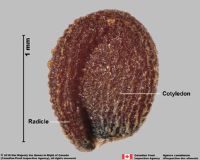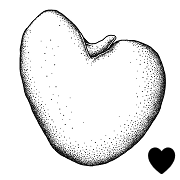Content is from Kirkbride et al. 2006Kirkbride et al. 2006:
Kirkbride JH, Jr, Gunn CR, and Dallwitz MJ. 2006. Family guide for fruits and seeds, vers. 1.0. Accessed September 2020-January 2022. URL: https://nt.ars-grin.gov/seedsfruits/keys/frsdfam/index.cfm ., without modification.
Updates are forthcoming.
Fruits: Pistil(s) compound; 1; 1-pistillate; with carpels united. Fruit anthocarpanthocarp:
simple or compound and including some tissue of non-ovarian origin (accessory tissue) ; simple; acrosarcum (Shepherdia), or pseudodrupe (Elaeagnus); without persistent central column; with styles(s); at apexapex:
; simple; acrosarcum (Shepherdia), or pseudodrupe (Elaeagnus); without persistent central column; with styles(s); at apexapex:
the point farthest from the point of attachment, or the "tip" of an organ ; within accessory organ(s); within hypanthium and calyxcalyx:
; within accessory organ(s); within hypanthium and calyxcalyx:
the outer whorl of the perianth; all the sepals of a flower ; accrescentaccrescent:
; accrescentaccrescent:
growing continuously
; persistent; with hypanthium achenes; with hypanthium wall distinct from fruit wall; with hypanthium composed of 2 layers; with hypanthium soft layer over hard layer; with hypanthium fleshy, or meally; 1-seeded; 1-seeded; with 1-carpellate; apexapex:
the point farthest from the point of attachment, or the "tip" of an organ not beaked; indehiscentindehiscent:
not beaked; indehiscentindehiscent:
not opening on its own, as in a fruit
 . Epicarpepicarp:
. Epicarpepicarp:
outer layer of fruit wall or pericarp, if divided into layers; note here used synonymously with exocarp durable; without armature; without wing(s); without apicalapical:
durable; without armature; without wing(s); without apicalapical:
at or pertaining to the end of the seed or fruit distal from its point of attachment (i.e., base)
respiratory hole. Mesocarpmesocarp:
the middle layer of the pericarp, if divided into layers present; fleshy; composed of 1 unified layer; without lactiform cavity system. Endocarpendocarp:
present; fleshy; composed of 1 unified layer; without lactiform cavity system. Endocarpendocarp:
the inner layer of the pericarp, if divided into layers present, or absent; not separating from exocarpexocarp:
present, or absent; not separating from exocarpexocarp:
outer layer of fruit wall or pericarp, if divided into layers; note here used synonymously with epicarp ; thin; not splitting into 1-seeded pyrenes; smooth; without wing; without operculumoperculum:
; thin; not splitting into 1-seeded pyrenes; smooth; without wing; without operculumoperculum:
a dehiscent cap (or lid) of a seed or fruit that opens during germination or dehiscence ; without secretory cavities; without mechanism for seedling escape; without grooves; without longitudinallongitudinal:
; without secretory cavities; without mechanism for seedling escape; without grooves; without longitudinallongitudinal:
of or relating to length or the lengthwise dimension
ridges. Funiculusfuniculus:
(alt. funicle) stalk connecting the ovule (later seed) to the ovary (later fruit) placenta short; short without seed bearing hookswith hooks:
short; short without seed bearing hookswith hooks:
bristles or spines with curved or backwards pointing tips, or with secondary bristles along their length (retinacula); not persisting in fruit after seed shed.
(retinacula); not persisting in fruit after seed shed.
Seeds: Arilaril:
(broad sense) appendicular structure that wholly or partly envelops a seed and is produced from or a modification of the funicle, raphe, or outer integument; usually fleshy or pulpy, sometimes spongy or tufted-capillate, often brightly colored absent. Seed larger than minute; 1 to less than 5 mm long to 5 to less than 10 mm long; 5 mm long (at least); straight (assumed); in transection tereteterete:
absent. Seed larger than minute; 1 to less than 5 mm long to 5 to less than 10 mm long; 5 mm long (at least); straight (assumed); in transection tereteterete:
approximately circular in cross section; width and thickness approximately equal
 (assumed); not bowl shaped; not nutlike; without winglike beakbeak:
(assumed); not bowl shaped; not nutlike; without winglike beakbeak:
a usually firm, terminal appendage, sometimes tapered ; without caudatecaudate:
; without caudatecaudate:
tapering to a long, tail-like appendage appendage(s); at maturity with food reserves; with endosperm; without canavanine. Sarcotestasarcotesta:
appendage(s); at maturity with food reserves; with endosperm; without canavanine. Sarcotestasarcotesta:
pulpy or fleshy outer layer of the seed coat, simulates aril absent. Testatesta:
absent. Testatesta:
seed coat
 present; without markedly different marginalmarginal:
present; without markedly different marginalmarginal:
at, on, or close to the margin or border
tissue; without fleshy or leatheryleathery:
texture—moderately thick, tough, and very pliable
layer over hard layer; tight; surface unsmooth, or smooth; surface with merged raised features; surface rugoserugose:
wrinkled ; without crease or line separating cotyledons from hypocotyl-radicle; with notch along margin where cotyledons from hypocotyl-radicle tip approaching each other; without glands; without bristles; glabrousglabrous:
; without crease or line separating cotyledons from hypocotyl-radicle; with notch along margin where cotyledons from hypocotyl-radicle tip approaching each other; without glands; without bristles; glabrousglabrous:
without hairs
; without wings; without collar; without operculumoperculum:
a dehiscent cap (or lid) of a seed or fruit that opens during germination or dehiscence ; colored; monochrome; membranousmembranous:
; colored; monochrome; membranousmembranous:
texture—extremely thin, pliable, and fairly tough
, or cartilaginouscartilaginous:
texture—firm, dense, tough, somewhat pliable, and resilient, like cartilage
; not becoming mucilaginousmucilaginous:
resembling mucilage; moist and sticky
when wetted; surrounding embryo (essentially). Hilumhilum:
on seeds, the scar indicating where the funiculus was attached; on grass caryopses, the scar visible on the outer fruit surface revealing where the seed is attached on the inner fruit wall surface; or in Asteraceae cypselae, the scar visible on the outer fruit wall revealing where the fruit was attached to the receptacle basalbasal:
basalbasal:
at or pertaining to the point of attachment; (of embryo) embryo occupies one end of the seed
. Rapheraphe:
a ridge or seam on the seed coat, formed by the portion of the funiculus united to the ovule wall in longitudinally curved ovules conspicuous; texture as testatesta:
conspicuous; texture as testatesta:
seed coat
 (assumed); described as "projecting". Endosperm development nuclear; trace; restricted to sheath around radicleradicle:
(assumed); described as "projecting". Endosperm development nuclear; trace; restricted to sheath around radicleradicle:
the embryonic root of the embryo (at least). Embryo differentiated from food reserve; well developed; 1 per seed; nearly filling testatesta:
(at least). Embryo differentiated from food reserve; well developed; 1 per seed; nearly filling testatesta:
seed coat
 (trace or scanty food reserve); 0.9 times the length of food reserve; at one end of seed not extending into a depression or cup; axileaxile:
(trace or scanty food reserve); 0.9 times the length of food reserve; at one end of seed not extending into a depression or cup; axileaxile:
on or of the axis
and centric; foliatefoliate:
appearing leaf-like
; with spatulatespatulate:
2D shape—like a spatula; rounded at the apex, with base long and tapered; (of embryo) embryo is straight and axile and centric with the cotyledons expanded to form the shape of a spatula or spoon; (of cotyledons) cotyledons expanded and wider than the stalk but not invested into the stalk cotyledons, or investinginvesting:
cotyledons, or investinginvesting:
(of embryo) embryo is nearly or completely filling seed coat, straight, and axile and centric with spatulate cotyledons and covering the stalk for at least half its length; (of cotyledons) cotyledons spatulate and covering the stalk for at least half its length
cotyledons; straight; parallel to seed length; with cotyledons abruptly connected to hypocotyl-radicle; without coleorhiza; without simmondsin; with cotyledons containing oils, or starch (occasionally); without stomata; not green; with 2 or more cotyledons. Cotyledons 2; well developed; 0.7–0.8 times length of embryo; somewhat to significantly wider than hypocotyl-radicle; 2–3.5 times wider than hypocotyl-radicle; partially concealing hypocotyl-radicle; not foliaceous; thick; flat; smooth; with apicesapex:
the point farthest from the point of attachment, or the "tip" of an organ entire; with margins separate; basally more or less cordatecordate:
entire; with margins separate; basally more or less cordatecordate:
2D shape—heart-shaped, with attachment at or near the broad end (compare obcordate) , or entire; equal in size; not punctatepunctate:
, or entire; equal in size; not punctatepunctate:
surface relief—dotted with pits or with translucent, sunken glands or with colored dots, similar to pitted dotted. Hypocotyl-radicle moderately developed; straight; not thickened.
dotted. Hypocotyl-radicle moderately developed; straight; not thickened.
Noxious weeds: 1 or more USA state noxious weeds in this family.
USA states and territories with listed noxious weeds: Colorado (CO), New Mexico (NM), Puerto Rico (PR), and West Virginia (WV).
USA state and territory noxious weeds:
Elaeagnus angustifolia L.: USA state noxious weed: CO●, NM●.
Elaeagnus multiflora Thunb.: USA state noxious weed: PR●.
Elaeagnus umbellata Thunb.: USA state noxious weed: WV●.
Symbols: ªaquatic weed; ●terrestrial weed; °weed in seed.
Last updated February 2006.
How to score: Fruit layers with hypanthium and to understand the quote from Cronquist: "Fruit drupe-like or berry-like, the dry acheneachene:
a dry, indehiscent, one-seeded fruit, with seed attached to pericarp at a single point, derived from a single, superior, simple or compound, one-loculed ovary enveloped by (but free from) the persistent base of the hypanthium, which becomes mealymealy:
enveloped by (but free from) the persistent base of the hypanthium, which becomes mealymealy:
loose, dry, and disintegrating in finely granular
pieces like meal or flour
or fleshy, very often with bonybony:
very hard and rather brittle, like bone
inner layer…" Fruit maybe hard or not - greatly hardened within fleshy hypanthium. Calyxcalyx:
the outer whorl of the perianth; all the sepals of a flower more mealymealy:
more mealymealy:
loose, dry, and disintegrating in finely granular
pieces like meal or flour
than juicy.
General references: Corner, E.J.H. 1976. The seeds of Dicots, esp. vol. 2. Cambridge University Press, New York, Cronquist, A. 1981. An integrated system of classification of flowering plants, 1,262 p. Columbia University Press, New York, Engler, A. & K. Prantl. 1924 and onward. Die Natürlichen Pflanzenfamilimien. W. Engelman, Leipzig, Gaertner, J. 1788–1805. De fructibus et seminibus plantarum. The Author, Stuttgart, Goldberg, A. 1986 (dicots) & 1989 (monocots). Classification, evolution, and phylogeny of the familes of Dicotyledons. Smithsonian Contr. Bot. 58 for dicots (314 pp.) & 71 for monocots (74 pp.). [Goldberg's illustrations are reproduced from older publications and these should be consulted], Gunn, C.R., J.H. Wiersema, C.A. Ritchie, & J.H. Kirkbride, Jr. 1992 & amendments. Families and genera of Spermatophytes recognized by the Agricultural Research Service. Techn. Bull. U.S.D.A. 1796:1–500, Mabberley, D.J. 1987. The plant-book, 706 p. Cambridge University Press, Cambridge, Schopmeyer, C.S. 1974. Seeds of Woodywoody:
texture—consisting mainly of indurate lignified tissues, characteristic of or resembling wood
plants in the United States. Agric. Handb. 450:1–883, and Spjut, R.W. 1994. A systematic treatment of fruit types. Mem. New York Bot. Gard. 70:1–182.